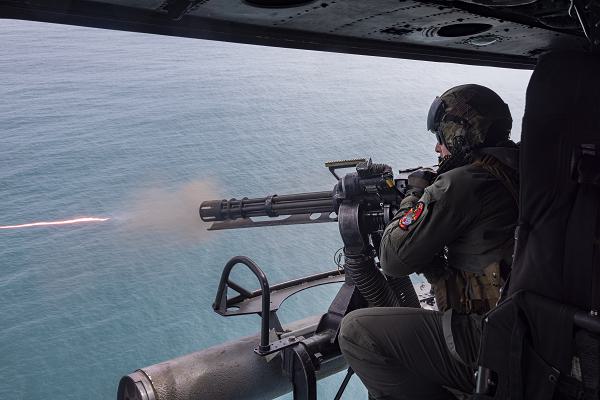
Skies Above North Carolina. (June 5, 2024): In 1861, a gunsmith named Richard Gatling had an idea, one that revolutionized warfare to this day. He invented the rotary cannon, a multiple barrel machine gun with a huge rate of fire that terrorized the enemy. In this photo by Lance Corporal Orlanys Diaz Figueroa, Gunnery Sergeant Parrish Hall II, a UH-1Y Venom crew chief with Marine Light Attack Helicopter Squadron 167, fires a GAU-17A minigun during live fire maritime to surface warfare training.
What began as a hand operated “Gatling Gun” has evolved into today’s multiple versions and capabilities, all of which are deadly. First used in combat by U.S. forces during the Civil War, the six-barrel gun went on to see service in the Japanese Civil War, the Anglo-Zulu Wars, and it even played a part in Teddy’s Roosevelt’s charge up San Juan Hill during the Spanish-American War.
These early versions used multiple barrels (up to ten) to limit overheating, a rotating mechanism, and a gravity fed reloading system that could fire up to two hundred rounds a minute. Despite its promise, the Gatling Gun fell out of favor with militaries of the time and Gatling himself ended up declaring bankruptcy.
Until World War II.
America and its allies found themselves battling large concentrations of enemy troops and desperately needed a way to even the score. Thus the “Vulcan” minigun series was born. The GAU-17A minigun is a member of the General Dynamics built Vulcan suite of high rate of fire weapons adapted to serve aboard Navy and Marine helicopters. Today, the GAU-17A has a selector switch to fire either 2,000 or 4,000 rounds per minute. It uses standard NATO 7.62 mm ammunition and is fired from a mount on the helicopter’s fuselage.
Little could Mr. Gatling imagine how his invention revolutionized warfare and continues to terrorize the enemy to this day.


